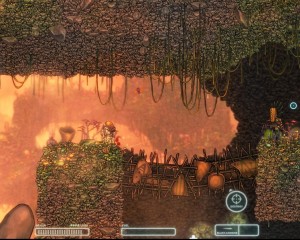Capsized: Deus
It wasn’t much longer after my last post that I finally finished the final level of Capsized, titled “Deus”. It’s a triple boss fight against big aliens, and it’s a learning experience. I mentioned in the last post how the final few levels make you learn to use the tractor beam (or magnetic grapple or whatever it’s actually called) for navigation. Deus makes you forget about that. It’s fought entirely in zero gravity, so you can float about endlessly and not have to worry about running out of jetpack fuel. And it’s something of a dirty trick, because in order to actually beat it, you have to use the tractor beam in other ways, which you have to figure out. For example, the first stage of the boss has an attack that consists of creating a sort of gravity well that pulls you in and hurts you. The only effective way to resist its pull is to quickly tether yourself to something stationary. The third stage creates and throws big spiky exploding things at you that home in on you and inevitably hurt you a lot unless you quickly grapple them and throw them away — preferably back at the boss, because that seems to be the only way to take down his shield. I don’t think I ever found any use peculiar to the second stage, though. It makes me wonder if there was some trick I missed.
After you kill each boss, you get a respite in which you can stop and pick up any ammo or health lying around, including stuff dropped by creatures that the boss summoned. You signal your readiness for the next stage by grappling a crystal dropped by the boss when it died and throwing it into what looks like a small volcano. (Small for a volcano, that is. It’s larger than the screen.) This, too, took me a good long while to figure out the first time. I hadn’t even noticed the crystal when it appeared, because I had been pretty much constantly running away from the boss when it was alive and didn’t stop immediately when it went into its death throes. The weird thing about this is that the game gives you pretty explicit instructions at each step of what to do. Throughout the game, there’s an onscreen compass pointing in the direction of your current objective (or the closest current objective, if there are multiple concurrent things), together with a single verb, like “collect” or “destroy”. But I had got into the habit of ignoring this. In most levels, what you actually want to do is explore. The compass isn’t always useful, because it always points straight at your objective, even if the direct way is blocked. But you can always find your goals by exploring thoroughly, and you’ll probably wind up finding some extra ammo caches on the way. So I had pretty much forgotten about the compass, even though it was right in front of my nose the whole time. Even once I had remembered it once, I kept forgetting to look at it when I wanted to know where the boss was lurking.
 Comments(1)
Comments(1)